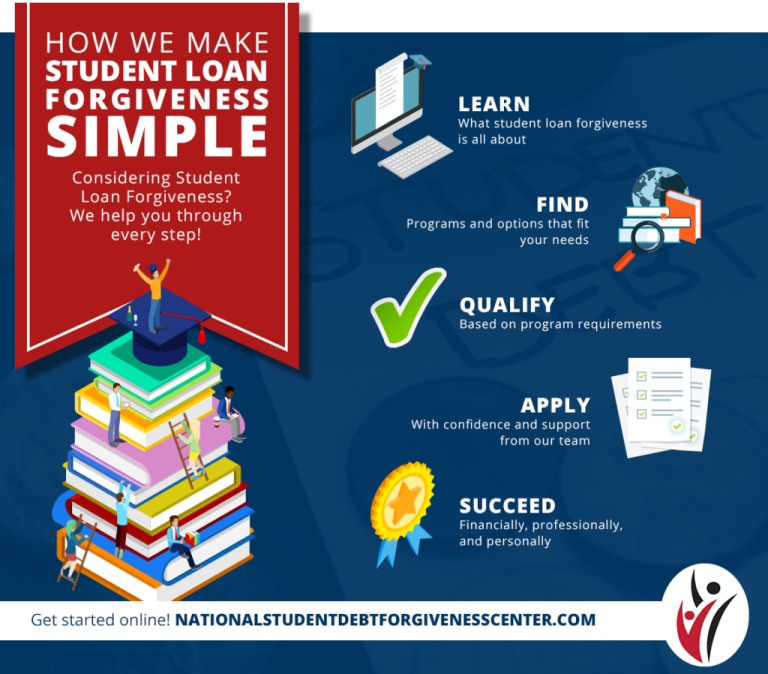Reduce your student loan by up to $300 a month (yes, really)
1 in 5 U.S. adults hold federal student loan debt. The national balance is a staggering $1.7 trillion. Student loan debt is the second highest source of household debt in America, and the average debt per borrower is $39,351. The estimated average monthly student loan payment is about $460 per month.
More and more, employers are looking for a solution to this crisis. That’s why we’re here.
Student Loan Debt Relief helps borrowers navigate federal forgiveness programs and puts them on the path to financial freedom from student loans.

What makes Student Loan Debt Relief Different?
Student Loan Counseling with a Personalized Action Plan
Average Savings: $250 per month / Average Loan Forgiveness: $24,000
Get one-on-one counseling with expert student loan consultants who specialize in loan forgiveness programs and will educate individuals on how to reduce their federal student loan debt
Personalized action plan based on borrower’s unique needs and eligibility
Ongoing education via on-demand webinars and bimonthly newsletters to keep borrowers informed
Guidance on federal loan consolidation, Income Driven Repayment (IDR) plans, and Public Service Loan Forgiveness (PSLF) qualifications
Assistance with federal loan consolidation, Teacher Loan Forgiveness (TLF), IDR account adjustment, Parent PLUS loans, total and permanent disability (TPD) discharge, annual recertification, PSLF credit backtracking, defaulted loan rehabilitation, and more
Additional end-to-end services that include all document preparation and process management to help with federal loan consolidation and loan modification programs* (available for a small fee)
How It Works

1. View an on-demand webinar to educate you on student loan debt relief programs and your options
2. Schedule a free 30-minute call with one of our Student Loan Specialists for a free, comprehensive consultation and analysis of your student loan portfolio
3.Determine eligibility for student debt relief programs
4. Develop a customized action plan based on helping you as efficiently as possible
5. By the end of the call, we outline how much we can reduce your loans and provide a personalized action plan on how to achieve these goals
6. If you decide to utilize our document preparation services, we carefully gather the necessary documentation needed for the programs and handle communication with loan servicers
Get on the path to financial freedom from student loan debt!

67% of student loan holders are age 39 or younger (29.5 million)
3rd most important benefit ranking of student loan debt relief behind health insurance and 401(k) match
86% of millennials would stay with an employer > 5 years if student loan relief benefit was offered
Student debt is strongly influencing decisions that can have significant ramifications on household economic stability, like emergency savings, and mobility, such as saving for a down payment on a home, starting a business, etc.
- Large proportions of student debt holders reported that they would pay down other debts, save more for emergencies, save for a down payment on a home, or save/save more for retirement if they were not burdened by student loan debt.
- 96% of student loan borrowers report putting off at least one major life or financial milestone due to student loan debt.
- 71% of borrowers said their student loan debt affected their ability to save for retirement.
- The average student loan accrues $26,000 in interest alone over 20 years.
- Up to 67% of the average borrower’s total cost of repayment is generated interest.

Meaningful benefits for all members.
Debt is not just a millennial problem:
Between 2012 and 2017, the average amount of student loan debt almost doubled for those age 60 and older.
$86 billion in student loan debt is owed by workers over 60 years of age, according to the Wall Street Journal.
Some seniors have even resorted to having Social Security benefits garnished.
Parent PLUS loans, which are taken out in the borrower’s parent’s name, draw off income that should be allocated to retirement savings.
It is also a powerful tool to support diversity, equity, and inclusion, as Black and Hispanic workers are significantly more likely to be saddled with higher levels of student loan debt.
